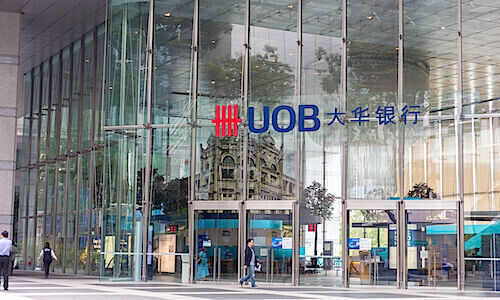UOB: Southeast Asia May Start Investing Before Banking
Southeast Asia’s path to financial inclusion appears likely to take routes around the banking box.
Getting Southeast Asia’s widely unbanked population to sign up for digital banking isn’t that difficult – it’s convincing those customers to stick around that’s challenging.
That’s according to Kevin Lam, head of TMRW and group digital banking at Singapore bank UOB.
«Ripe Ground»
«It's not difficult to convince Southeast Asian customers to take up digital banking. In fact, we find that it's a very ready and ripe ground for the take up of digital services, not just banking,» Lam told finews.asia recently.
But the region’s customers need a compelling value proposition for customers to not only download a banking app, but actually fund the accounts, Lam said.
«Having a digital bank doesn't make us profitable automatically, or lower the costs, until we can get customers to sign up for products, to put more balances, whether it's deposits or borrowing, in a sustainable way,» he said.
Customer Quality
Lam cited concerns over a proliferation of digital bank launches claiming high numbers of customers, saying the quality of the user base may need examination, particularly for whether the accounts are actually funded and the average deposit balance for customers across various products.
To be sure, the potential pool of customers for banking and wealth management growth in Southeast Asia is huge.
Of the around 400 million adults in Southeast Asia, around 198 million are unbanked – or don’t have a bank account – while another 98 million are underbanked, with a bank account, but without access to credit, investments and insurance, according to the e-Conomy SEA 2019 report published by Google, Temasek and Bain & Co. in October 2019, prior to the start of the Covid-19 pandemic.
Since the pandemic began, the region has seen a widely reported pickup in adoption. Indeed, Lam cited data from UOB’s Asean consumer sentiment survey – conducted in Singapore, Indonesia, Malaysia, Thailand and Vietnam – as showing 80 percent of respondents saying they’d increased their usage of mobile apps to perform banking services last year. In digital’s harder-to-reach age group of 45 years and older, more than 60 percent said they were prepared to use digital banking as of late last year, compared with around 20 percent in 2019, shortly before the pandemic, Lam said.
«Storing Money»
But Lam noted UOB isn’t targeting the unbanked for its customer base, and is instead seeking out the «underserved», or the near-prime market which is growing toward the prime bankable population. But that population may have less interest in funding a bank account.
«When you open a bank account, you're talking about just storing excess money that you have in the hope of a very marginal return on your deposits,» Lam said, adding that’s spurring more interest in wealth management and investing than in bank accounts.
Targeting First-Time Investors
He noted UOB has a product in Singapore called SimpleInvest, which allows investments from as low as S$100 (US$73); it’s offered to the bank’s customers. More than 90 percent of signups for the product are from first-time investors, according to UOB’s annual report. The products offered include more than 100 unit trusts.
Opening a bank account also has a fairly high bar for «know your customer,» or KYC, which can create hurdles for under-served groups, Lam noted, adding that investment platforms may have more liberal standards.
In addition, in regional markets outside Singapore, assets are being fractionalized, allowing investors to invest for as little as US$1, Lam noted.
Leapfrog to Wealth Management
«We are seeing that kind of situation where people actually open investment accounts before they open bank accounts,» he said.
For example, Indonesian app-based wealth management startup Pluang started with gold-based offerings, as Indonesia is a Muslim-majority market, but later gravitated its users toward riskier products such as stocks and crypto. The startup's founder, Claudia Kolonas, recently said Pluang is seeing users engage with wealth management platforms before looking at banks or even e-wallets.
To be sure, Lam noted at the high-end of the wealth management market, private banks show little sign of going fully digital.
Private Banks Keep Human Touch
«We are not seeing, in Southeast Asia at least, as many pure private bank digital plays,» Lam said, adding the trend is more toward digital investments to allow private banking customers to collaborate more easily with relationship managers.
«I think those customers, in this part of the world, still feel that they would prefer to get a human to do it for them,» Lam said.
Lam cited other concerns in Southeast Asia’s road to financial inclusion via digital offerings.
For one, with private equity and venture capital financing supporting startups, pricing in financial services can be «irrational,» he said, pointing to excessive fixed deposit rates and lending rates, which misallocates capital. That kind of unsecured lending can build consumer debt in ways that can destabilize the economy, he said, citing the growth in Buy Now Pay Later (BNPL) lending.
«Irrational» Pricing?
As an example of BNPL's proliferation, within Singapore, at least one payment app allows users to fractionalize payments for purchases as small as a cup of kopi, or the local coffee.
BNPL’s growth may be déjà vu for the microfinance blowup a little over a decade ago. At the time, microfinance shifted from the provenance of careful, targeted non-profit loans aimed at alleviating poverty, toward private equity funds taking advantage of the relatively high lending interest rates to blanket emerging markets with consumer loans. In some parts of India, that had spurred a payment strike after low-income borrowers became buried in high-interest debt.
The BNPL segment is seeing strong growth in Southeast Asia, with consumer search interest up 16 times in 2021, driven largely by Indonesia, according to the e-Conomy SEA report published by Google, Temasek and Bain & Co. in November 2021. Digital lending to consumers as a whole, including BNPL, is expected to rise to US$92 billion by 2025, up from US$33 billion in 2021, the report said.
BNPL Growth
In Singapore, BNPL adoption is expected to grow at a compound annual growth rate of around 18 percent from 2021 to 2028, projected to reach a gross merchandise value of US$1.84 billion by 2028 from US$370.8 million in 2020, according to research from Research and Markets published in August 2021.
Around 38 percent of Singaporeans, or around 1.1 million people, had used a BNPL service, according to a survey of 1,008 Singaporeans over the age of 16 conducted by consumer research firm Milieu Insight in October 2020.
The data showed not all is rosy in Singapore’s BNPL offerings.
Not All Is Rosy
Just over half of respondents who were unemployed and not looking for a job have used BNPL, above the national total, the data showed. Around 27 percent of Singaporeans surveyed said they were worse off financially due to a BNPL mistake, with many saying the reason was making an impulse purchase, the data showed.
Around 11 percent said they’d overstretched their budget to the point of struggling to pay for other expenses, and around 7 percent said their bank account was over-drafted due to BNPL use, the survey found.
«Value System»
To be sure, Lam noted that contrary to conventional wisdom, low-income customers regionally do not have higher loss rates than their higher income peers.
«We discovered that people with lower income are not necessarily poorer borrowers,» Lam said. «People with lower income in many of these markets are actually performing and behaving better than people with higher income if they have the right value system … they choose to live within their means and they are responsible about repayment.»
Lam also pointed to another concern around the new financial services options available to consumers, particularly those using non-traditional data points.
Untested Data
He noted that the data may only be up to around seven years old, and hasn’t been tested through a major economic downturn. During the Covid pandemic, many central banks, particularly in Southeast Asia, created loan moratorium programs, which protected lenders from delinquencies.
«If the next cycle comes, that is not pandemic-induced, just another one of those excessive risk-taking, over-exuberance [economic events], some of these [fintechs] that are overly focused on disruption, with a lack of governance, and a lack of long-term thinking, then those data will be put to test,» he said.




























